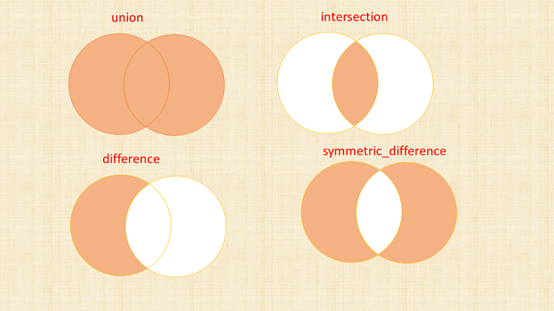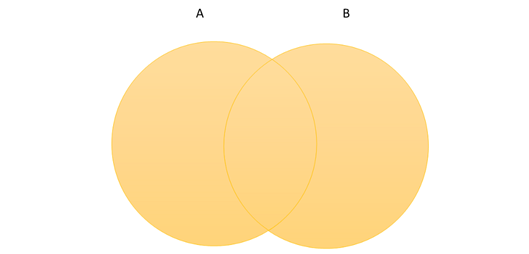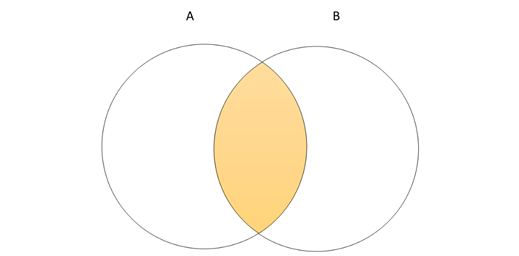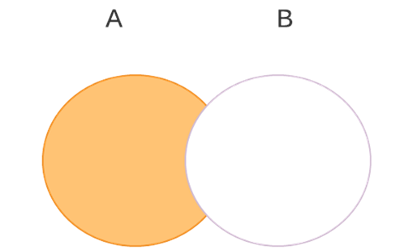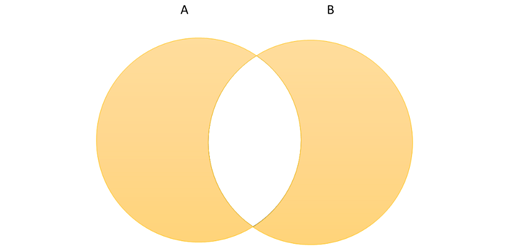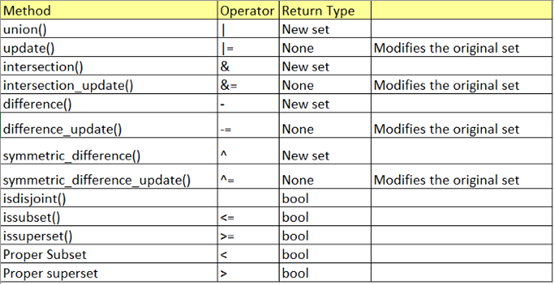set是Python中无序的集合,它可以用于计算标准数学运算,例如交集、并集、差集和对称差集,Other集合(例如列表、元组和字典)不支持集合操作,Dict视图对象类似于集合,可以进行集合操作。本文将详细探讨set对象支持的数学运算。
先来看一下Set对象支持的数学运算:
- union()
- update()
- intersection()
- intersection_update()
- difference()
- difference_update()
- symmetric_difference()
- symmetric_difference_update()
- isdisjoint()
- issubset()
- issuperset()
Set运算操作可以通过两种方式完成:使用方法或运算符。
‘union()’
返回一个新集合,其中包含该set和other集合中的元素,使用union()或“|“算子。
语法:
- union(*others)
- set | other | ...
示例1:找到两个集合的并集—A和B
返回一个包含集合A和集合B中的元素的新集合。但元素不会重复,集合中的所有元素都是唯一的。
- A={1,2,3,4,5}
- B={2,4,6,8}
- print (A.union(B))#Output:{1, 2, 3, 4, 5, 6, 8}
- print (A|B)#Output:{1, 2, 3, 4, 5, 6, 8}
示例2:查找两个以上集合的并集
- A={1,2,3,4,5}
- B={2,4,6,8,10}
- C={1,3,5,7,9}
- print (A|B|C)#Output:{1, 2, 3, 4, 5, 6, 7, 8, 9, 10}
- print (A.union(B,C))#Output:{1, 2, 3, 4, 5, 6, 7, 8, 9, 10}
union()方法和|之间的区别:
- union():接受任何可迭代的参数
- |运算符:仅接受set作为参数,否则将引发TypeError。
示例3:在union()方法中将iterable用作参数
- A={1,2,3,4,5}
- #iterable is given as list
- print (A.union([2,4,6]))#Output:{1, 2, 3, 4, 5, 6}
- #iterable is given as tuple
- print (A.union((2,4,6)))#Output:{1, 2, 3, 4, 5, 6}
- #iterable is given as range object
- print (A.union(range(5,10)))#Output:{1, 2, 3, 4, 5, 6, 7, 8, 9}
- #iterable is given as a dictionary
- print (A.union({'a':6,'b':7}))#Output:{1, 2, 3, 4, 5, 'b', 'a'}
示例4:为|提供参数iterable
- A={1,2,3,4,5}
- B=[1,2,3]
- print (A|B)
- #Output:TypeError: unsupported operand type(s) for |: 'set' and 'list'
‘update()’
更新集合,并从other集合中添加元素,元素不会重复,集合中的所有元素都是唯一的。通过使用update() 或使用|=运算符来执行,返回类型为None,将修改原始集本身。
语法:
- update(*others)
- set |= other | ...
示例1:在A和B两个集合之间调用update()
通过添加两个集合中的元素来更新集合A。
- #update()
- A={1,2,3,4,5}
- B={4,5,6,7,8}
- print (A.update(B)) #Output: None
- print (A) #Output: {1, 2, 3, 4, 5, 6, 7, 8}A={1,2,3,4,5}
- B={4,5,6,7,8}
- A|=B
- print (A) #Output: {1, 2, 3, 4, 5, 6, 7, 8}
示例2:在两个以上集合之间调用update()
- #update()
- A={1,2,3}
- B={3,4,5}
- C={5,6,7}
- print (A.update(B,C)) #Output: None
- print (A) #Output: {1, 2, 3, 4, 5, 6, 7}
- A={1,2,3}
- B={3,4,5}
- C={5,6,7}
- A|=B|C
- print (A) #Output: {1, 2, 3, 4, 5, 6, 7}
update() 方法和|=运算符之间的区别:
- update() :接受任何可迭代的参数。
- =运算符:仅接受set作为参数,否则将引发TypeError。
示例3:在update() 方法中将iterable用作参数
- A={1,2,3}
- #iterable is given as list
- print (A.update([2,3,4]))#Output:None
- print (A)#Output:{1,2,3,4}
- #iterable is given as tuple
- A={1,2,3}
- A.update((2,3,4))
- print (A)#Output:{1,2,3,4}
- #iterable is given as range object
- A={1,2,3}
- A.update(range(2,5))
- print (A)#Output:{1,2,3,4}
- #iterable is given as a dictionary
- A={1,2,3}
- A.update({2:'a',3:'b'})
- print (A) #Output:{1, 2, 3}
示例4:为|=运算符提供参数iterable:
- #iterable is given as tuple
- A={1,2,3}
- B=(3,4)
- A|=B#Output:TypeError: unsupported operand type(s) for |=: 'set' and 'tuple'
‘intersection()’
返回一个具有该集合和other集合共同元素的新集合,通过intersection()或使用&运算符来执行。
语法:
- intersection(*others)
- set & other & ...
示例1:找到两个集合的交集—A和B
返回一个新集合,其中包含集合A和集合B中的共同元素。
- A={1,2,3,4,5}
- B={2,4,6,8}
- #intersection is performed by intersection() method or & operator
- print (A.intersection(B))#Output:{2,4}
- print (A&B)#Output:{2,4}
示例2:找到两个以上的交集
- A={1,2,3,4,5}
- B={2,4,6,8,10}
- C={2,4}
- print (A&B&C)#Output:{2,4}
- print (A.intersection(B,C))#Output:{2,4}
intersection()方法和&运算符之间的区别:
- intersection():接受任何可迭代的参数。
- &运算符:仅接受set参数,否则将引发TypeError。
示例3:在intersection()方法中将iterable用作参数
- A={1,2,3,4,5}
- #iterable is given as list
- print (A.intersection([1,4,6]))#Output:{1,4}
- #iterable is given as tuple
- print (A.intersection((2,4,6)))#Output:{2,4}
- #iterable is given as range object
- print (A.intersection(range(5,10)))#Output:{5}
- #iterable is given as a dictionary
- print (A.intersection({1:'a','b':7}))#Output:{1}
示例4:为&运算符提供参数iterable
- A={1,2,3,4,5}
- B=[1,2,3]
- print (A&B)
- #Output:TypeError: unsupported operand type(s) for &: 'set' and 'list'
‘intersection_update()’
更新集合,只保留集合和other中共同的元素。可以通过使用 intersection_update()或使用&=运算符来执行,返回类型为None,将修改原始集本身。
语法:
- intersection_update(*others)
- set &= other & …
示例1:找到两个集合A和B之间的 intersection_update()
通过仅保留在两个集合中找到的元素来更新集合A。
- #intersection_update()
- A={1,2,3,4,5}
- B={4,5,6,7,8}
- print (A.intersection_update(B)) #Output: None
- print (A) #Output: {4,5}A={1,2,3,4,5}
- B={4,5,6,7,8}
- A&=B
- print (A) #Output: {4,5}
‘difference()’
返回一个去除other中元素之后的新集合,通过difference() 或使用-运算符来执行。
语法:
- difference(*others)
- set - other - ...
示例1:找出A和B两组之间的差异
返回一个新集合,其中包含在集合A而不在集合B中的元素。
- A={1,2,3,4,5}
- B={2,4,6,8}
- print (A.difference(B))#Output:{1,3,5}
- print (A-B)#Output:{1,3,5}
示例2:找出两个以上集合之间的差异
- A={1,2,3,4,5}
- B={2,4,6,8,10}
- C={2,3}
- print (A-B-C)#Output:{1,5}
- print (A.difference(B,C))#Output:{1,5}
difference()方法和-运算符之间的区别:
- difference():接受任何可迭代的参数
- -运算符:仅接受set作为参数。否则将引发TypeError。
示例3:在difference()方法中将iterable作为参数
- A={1,2,3,4,5}
- #iterable is given as list
- print (A.difference([1,2,3]))#Output:{4,5}
- #iterable is given as tuple
- print (A.difference((1,2,3)))#Output:{4,5}
- #iterable is given as range object
- print (A.difference(range(1,4)))#Output:{4,5}
- #iterable is given as a dictionary
- print (A.difference({1:'a',2:'b',3:'c'}))#Output:{4,5}
示例4:为-运算符提供参数iterable
- A={1,2,3,4,5}
- B=[1,2,3]
- print (A-B)
- #Output:TypeError: unsupported operand type(s) for -: 'set' and 'list'
‘difference_update()’
从other集合中删除该集合中的元素,通过使用-= 运算符或使用difference_update() 方法来执行,返回类型为None,将修改原始集本身。
句法:
- difference_update(*others)
- set -= other | ...
示例1:找出A和B两组之间的差异
返回一个新集合,其中包含在集合A而不在集合B中的元素。
- A={1,2,3,4,5}
- B={2,4,6,8}
- print (A.difference(B))#Output:{1,3,5}
- print (A-B)#Output:{1,3,5}
示例2:找出两个以上集合之间的差异
- A={1,2,3,4,5}
- B={2,4,6,8,10}
- C={2,3}
- print (A-B-C)#Output:{1,5}
- print (A.difference(B,C))#Output:{1,5}
difference()方法和-运算符之间的区别:
- difference():接受任何可迭代的参数
- -运算符:仅接受set作为参数。否则将引发TypeError。
示例3:在difference()方法中将iterable作为参数
- A={1,2,3,4,5}
- #iterable is given as list
- print (A.difference([1,2,3]))#Output:{4,5}
- #iterable is given as tuple
- print (A.difference((1,2,3)))#Output:{4,5}
- #iterable is given as range object
- print (A.difference(range(1,4)))#Output:{4,5}
- #iterable is given as a dictionary
- print (A.difference({1:'a',2:'b',3:'c'}))#Output:{4,5}
示例4:为-运算符提供参数iterable
- A={1,2,3,4,5}
- B=[1,2,3]
- print (A-B)
- #Output:TypeError: unsupported operand type(s) for -: 'set' and 'list'
‘difference_update()’
从other集合中删除该集合中的元素,通过使用-= 运算符或使用difference_update() 方法来执行,返回类型为None,将修改原始集本身。
句法:
- difference_update(*others)
- set -= other | ...
示例1:找到两个集合A和B之间的difference_update()
通过删除集合A和集合B中都存在的元素来更新集合A。
- A={1,2,3,4,5}
- B={2,4,6}
- #Return type is None.
- print (A.difference_update(B))#Output:None
- #It will update the original set
- print (A) #Output: {1,3,5}
- # difference_update by using -= operator
- A-=(B)
- print (A) #Output: {1,3,5}
示例2:查找两个以上集合之间的difference_update
- #difference_update() will modify the original set.
- A={1,2,3}
- B={1}
- C={2}
- #Return type is None.
- print (A.difference_update(B,C))#Output:None
- #It will update the original set
- print (A) #Output: {3}
- # difference_update by using -= operator
- A={1,2,3}
- B={1}
- C={2}
- A-=B|C
- print (A) #Output: {3}
difference_update()方法与-=运算符的区别:
- difference_update():接受任何可迭代的参数
- -=运算符:仅接受set参数,否则将引发TypeError。
示例3:在difference_update()方法中将iterable作为参数
- #iterable is given as list
- A={1,2,3}
- B=[1]
- print (A.difference_update(B))#Output:None
- print (A)#Output:{2,3}
示例4:为-=运算符提供参数iterable
- A={1,2,3}
- B=[1]
- A-=Bprint (A)#Output: TypeError: unsupported operand type(s) for -=: 'set' and 'list'
‘symmetric_difference()’
返回一个新集合,该集合中的元素属于集合或other,但不包含两个集合共有的元素。通过symmetric_difference()或使用^运算符来执行。
语法:
- symmetric_difference(other)
- set ^ other
示例1:找到A和B两组之间的对称差
返回一个新集合,其中包含来自集合A和集合B的元素,但不包含两个集合中共同的元素。
- A={1,2}
- B={2,3}
- print (A.symmetric_difference(B))#Output:{1,3}
- print (A^B)#Output:{1,3}
示例2:对称差集仅适用于2个集合
多个集合不支持symmetric_difference()方法,如果给出两个以上的集合,则会引发TypeError。
- A={1,2}
- B={2,3,5}
- C={3,4}
- print (A.symmetric_difference(B,C))#Output:TypeError:symmetric_difference() takes exactly one argument (2 given)
但是我们可以使用^找到多个集合的对称差集
- A={1,2}
- B={2,3,5}
- C={3,4}
- print (A^B^C)#Output:{1,4,5}
symmetric_difference()方法和^运算符之间的区别:
- symmetric_difference():接受任何可迭代的参数,但此方法不允许使用多个集合。
- ^运算符:它将仅接受set作为参数。否则,将引发TypeError。通过使用^运算符,可以找到多个集合之间的对称差集。
示例3:在symmetric_difference()方法中将iterable作为参数
- #iterable is given as list
- A={1,2,3}
- B=[1]
- print (A.symmetric_difference(B))#Output:{2,3}
- #iterable is given as tuple
- A={1,2,3}
- B=(1,)
- print (A.symmetric_difference(B))#Output:{2,3}
- #iterable is given as range object
- A={1,2,3}
- B=range(2)
- print (A.symmetric_difference(B))#Output:{2,3}
示例4:为^运算符提供参数iterable:
- A={1,2,3}
- B=[1]
- A^Bprint (A) #Output: TypeError: unsupported operand type(s) for ^: 'set' and'list'
‘symmetric_difference_update()’
更新集合,保留在两个集合中均找到的元素并去除两个集合中的公共元素。可以通过使用symmetric_difference_update()或使用^=运算符来实现,返回类型为None,将修改原始集本身。
语法:
- symmetric_difference_update(other)
- set ^= other
示例1:在A和B两组之间找到symmetric_difference_update()
将通过仅保留能在任一集合中找到,但不在两个集合中同时出现的元素来更新集合A。
- #symmetric_difference_update()
- A={1,2,3,4,5}
- B={4,5,6,7,8}
- print (A.symmetric_difference_update(B)) #Output: None
- print (A) #Output: {1, 2, 3, 6, 7, 8}
- A={1,2,3,4,5}
- B={4,5,6,7,8}
- A^=B
- print (A) #Output: {1, 2, 3, 6, 7, 8}
‘isdisjoint()’
如果该集合没有共同元素,则返回True。当且仅当它们的交集为空集时,这时称集合之间无连接。
语法:
- isdisjoint(other)
示例
- #Set A and Set B containing common elements
- A={1,2,3,4,5}
- B={4,5,6,7,8}
- print (A.isdisjoint(B))#Output:False
- #Set A and Set B not containing common elements
- A={1,2}
- B={3,4}
- print (A.isdisjoint(B))#Output:True
‘issubset()’
测试集合中的每个元素是否都在other元素中。
语法:
- issubset(other)
- set <= other
示例:检查集合A是否为集合B的子集
可以通过issubset()方法或使用≤运算符来完成。
- A={1,2,3,4,5}
- B={4,5,6,7,8}
- print (A.issubset(B)) #Output: False
- print (A<=B)#Output: False
- A={1,2,3}
- B={1,2,3,4,5}
- print (A.issubset(B)) #Output: True
- print (A<=B)#Output: False
Proper subset
测试集合是否为other的真子集,即set <= otherand set != other。
句法:
- set < other
示例:检查集合A是否是B的真子集
如果两个集合相等,则意味着 A.issubsetset(B) 返回True,但是真子集A
- A={1,2,3,4,5}
- B={4,5,6,7,8}
- print (A<B)#Output: False
- A={1,2,3,4,5}
- B={1,2,3,4,5}
- print (A<B)#Output: False
- A={1,2,3}
- B={1,2,3,4,5}
- print (A<B)#Output: True
‘issuperset()’
测试other中的每一个元素是否在集合中。
语法:
- issuperset(other)
- set >= other
示例:检查集合A是否为B的超集
可以通过issuperset()方法或使用≥运算符来实现:
- A={1,2,3,4,5}
- B={4,5,6,7,8}
- print (A.issuperset(B)) #Output: False
- print (A>=B)#Output:True
- A={1,2,3,4,5}
- B={1,2,3}
- print (A.issuperset(B)) #Output: True
- print (A>=B)#Output:True
Proper superset
测试集合是否是other集合的真超集,即,set >= otherand set != other。
语法:
- set > other
示例:检查集合A是否为B的真超集。
如果两个集合相等,则意味着A.issuperset(B)返回True,但是真超集A> B将返回False。
- A={1,2,3,4,5}
- B={4,5}
- print (A>B)#Output: True
- A={1,2,3,4,5}
- B={1,2,3,4,5}
- print (A>B)#Output: False
- A={1,2,3}
- B={1,2,3,4,5}
- print (A>B)#Output: True
总结
Frozenset不支持所有更新方法,frozenset类型不可变且不可哈希创建,一旦创建内容无法更改。由于所有更新方法都修改了原始集,所以frozenset不支持它。
我们可以通过两种方式执行数学集合设置操作:使用运算符或使用一种方法。其不同之处在于,如果使用方法,将接受iterable作为参数。但是对于运算符,仅应设置参数。如果不是,则会引发 TypeError。所有更新方法都会更新原始集,frozenset不支持该更新。除了更新方法外,所有其他方法都返回一个新集合。













